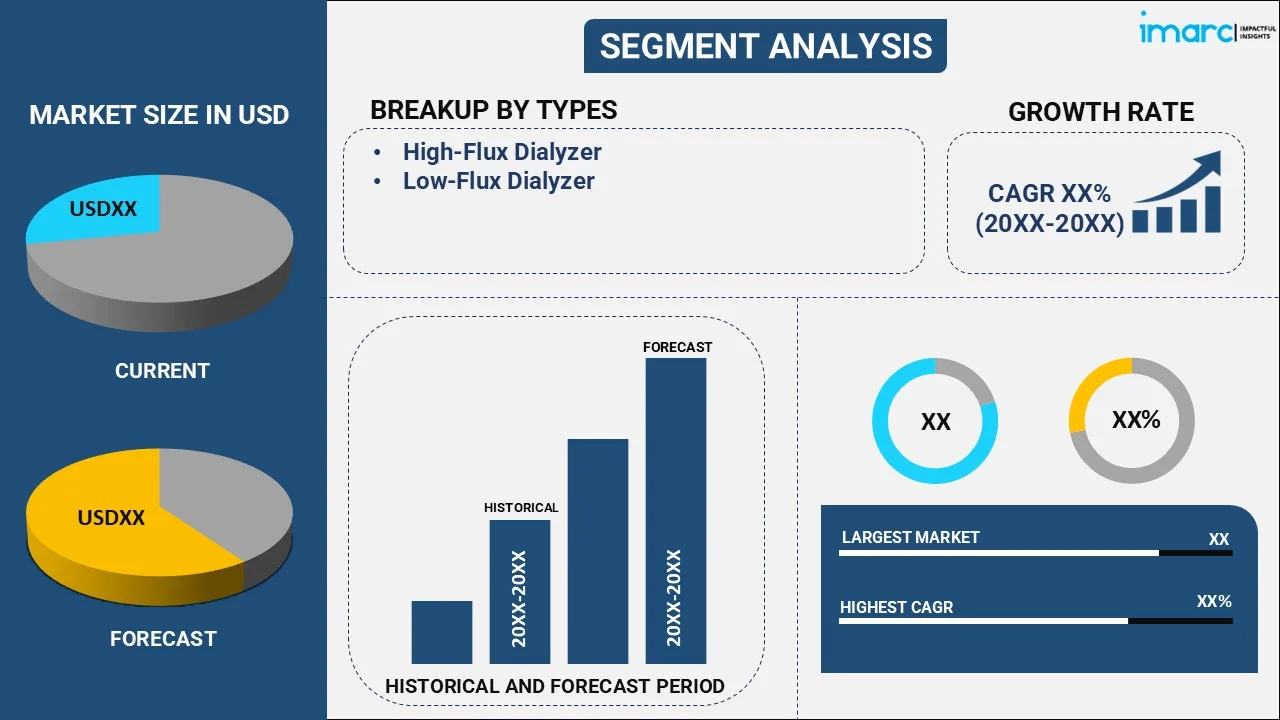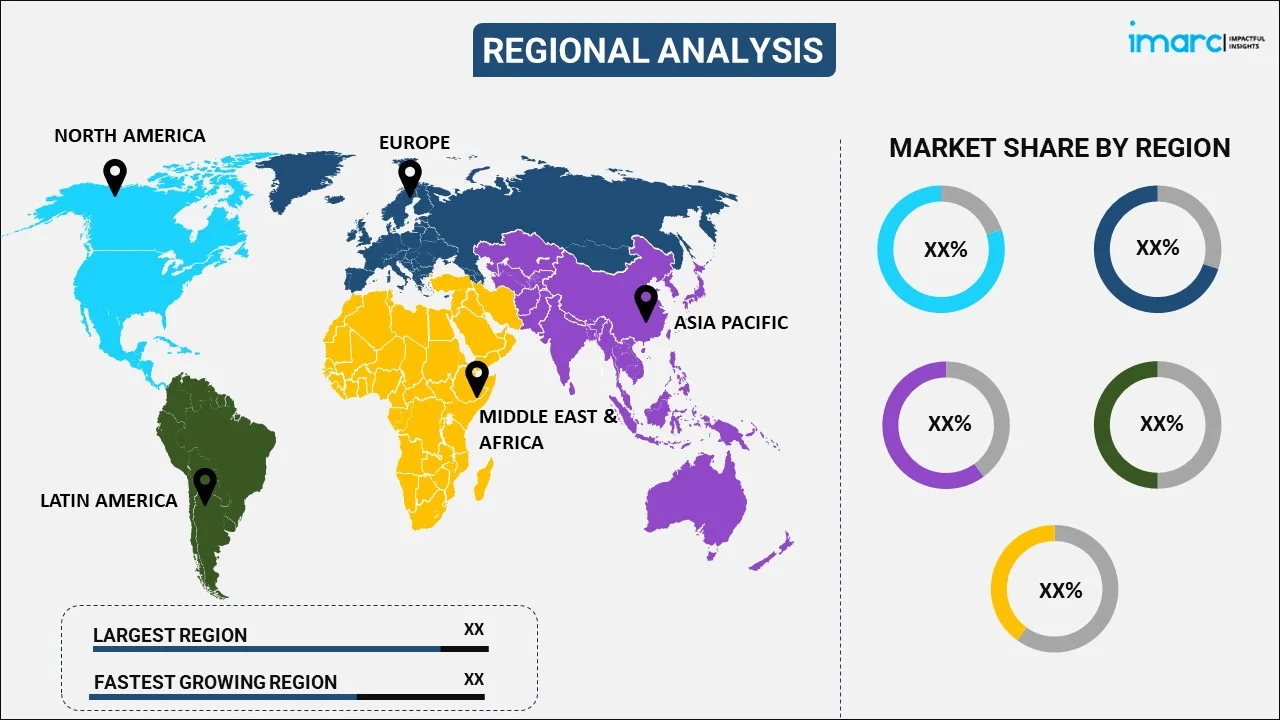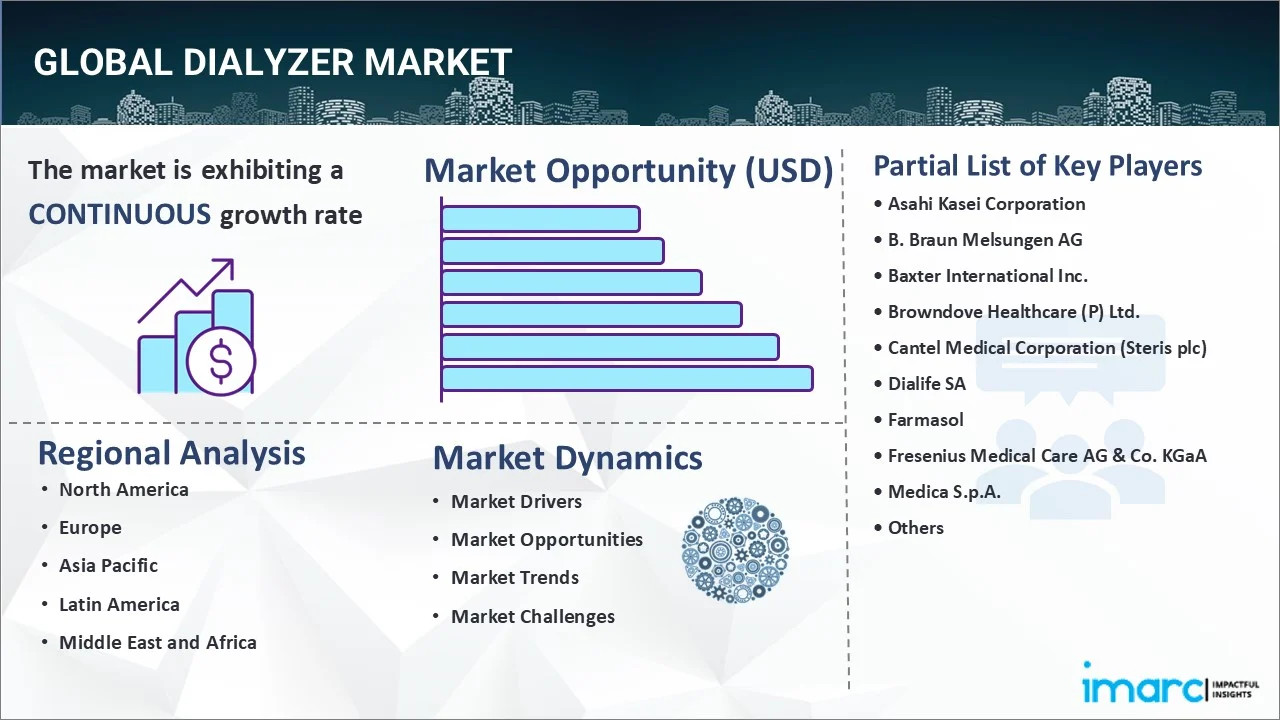
Dialyzer Market Report by Type (High-Flux Dialyzer, Low-Flux Dialyzer), Usage Type (Disposable, Reusable), End User (Hospitals and Clinics, Ambulatory Surgical Centers, Home Care Settings, Dialysis Centers), and Region 2025-2033
Dialyzer Market Market Overview:
The global dialyzer market size reached USD 3.8 Billion in 2024. Looking forward, IMARC Group expects the market to reach USD 5.7 Billion by 2033, exhibiting a growth rate (CAGR) of 4.37% during 2025-2033. North America dominated the market in 2024. The growing preferences for home dialysis, rising prevalence of lifestyle-related diseases, such as diabetes and hypertension, which often lead to kidney problems, increasing demand for dialysis services, and implementation of supportive government policies and reimbursement programs are some of the factors contributing to the dialyzer market share.
|
Report Attribute
|
Key Statistics
|
|---|---|
|
Base Year
|
2024
|
|
Forecast Years
|
2025-2033
|
|
Historical Years
|
2019-2024
|
|
Market Size in 2024
|
USD 3.8 Billion |
|
Market Forecast in 2033
|
USD 5.7 Billion |
| Market Growth Rate 2025-2033 | 4.37% |
A dialyzer, also known as an artificial kidney, is an apparatus manufactured using a thin and fibrous material to form a semipermeable membrane, which allows smaller particles and liquids to pass through. It is a cost-effective solution that removes excess fluids and wastes from the blood when kidneys are unable to function properly and prevents accumulation of salt and poisoning. It offers several advantages, such as less waste disposal, minimizing environmental impact, decreasing the frequency of first use syndrome, and improving biocompatibility. As a result, it finds extensive applications in in-center dialysis and home dialysis across the globe.
Dialyzer Market Trends:
Growing Prevalence of Chronic Kidney Disease (CKD)
Chronic kidney disease (CKD) often advances to end-stage renal disease, where dialysis becomes essential for patient survival. A growing number of diabetes and hypertension cases, both key risk factors, are contributing significantly to kidney failure rates, increasing the need for dialysis treatment worldwide. This growing patient base is motivating dialyzer manufacturers to enhance product efficiency and performance. At the same time, broader awareness of kidney-related health issues is driving earlier detection and proactive management, further fueling industry expansion. According to the 2023 ISN-Global Kidney Health Atlas (ISN-GKHA) report, around 850 Million people globally were affected by CKD. These trends underscore the importance of accurate dialyzer market forecast data to support planning and investment in the sector.
Growing Elderly Population Increasing Demand for Renal Care
The expanding elderly population is one of the main factors behind the rising need for dialysis treatment. Kidney function typically declines with age, and chronic conditions like diabetes and hypertension, both leading causes of kidney failure, are more common in older adults. As a result, more individuals require regular hemodialysis, which has increased the consumption of dialyzers. Countries with aging demographics, including Japan, South Korea, Italy, and Germany, are already experiencing the effects of this shift. Healthcare systems are adapting by expanding dialysis centers, increasing funding for chronic kidney care, and encouraging innovation in dialysis equipment. Manufacturers are also focusing on producing dialyzers that are gentler and more efficient, particularly suited for frail patients. This demographic shift is not temporary; it’s a structural change that will shape healthcare planning, procurement, and delivery models in the years ahead, especially in regions where older populations are growing fastest.
Increasing Demand for Home Dialysis
Home dialysis treatments are becoming more popular as they give patients the freedom to manage their health without significantly disrupting their routines. This shift is pushing manufacturers to design portable, easy-to-use dialyzers that suit patients’ needs for mobility and simplicity. Healthcare providers are also supporting this trend, as home dialysis reduces strain on hospital dialysis units and clinics. New advances in remote monitoring technology are making it easier for medical professionals to supervise treatments remotely, ensuring safety and continuity of care. These developments are contributing to the growth of home-based dialysis solutions. In 2023, Dialyze Direct partnered with Northeast Georgia Health Ventures (NGHV) to deliver onsite home hemodialysis for skilled nursing facility (SNF) residents in Georgia. This initiative aimed to improve outcomes by offering more frequent, gentler dialysis treatments in a familiar setting. According to current dialyzer market analysis, these kinds of partnerships and innovations are expected to play a key role in shaping future demand and product design.
Favorable Government Initiatives and Reimbursement Policies
Several regions are changing their healthcare policies to make dialysis more affordable and easier to access. Subsidies and financial aid programs are helping patients handle the ongoing costs of chronic kidney disease earlier in their treatment. Insurance providers are now covering dialysis more broadly, reducing out-of-pocket expenses and encouraging more people to start treatment sooner. Governments are also supporting hospitals by supplying modern dialysis machines, making sure clinics are better equipped. In 2024, Dr. Mansukh Mandaviya launched 27 greenfield bulk drug parks and 13 new medical device manufacturing plants under India’s PLI scheme. Among them were dialyzer manufacturing facilities by Nipro India Corporation in Satara, Maharashtra, and Poly Medicure Limited in Faridabad, Haryana. These plants are meant to strengthen India’s ability to produce critical medical devices locally and cut down on imports.
Innovation in Dialysis Technology Enhancing Patient Outcomes
Ongoing advancements in dialysis technology are reshaping the way care is delivered and improving the overall treatment experience for patients. Modern dialyzers are now being designed with high-flux membranes that offer better clearance of toxins while preserving essential proteins, which helps reduce complications. Integration of sensors and digital monitoring systems is also gaining traction, enabling more precise control over fluid removal and treatment parameters. Some systems now support remote monitoring, allowing clinicians to adjust settings in real time based on patient-specific data. These changes not only improve safety but also reduce hospitalization rates and treatment fatigue. Compact and portable dialysis machines are making home-based dialysis more feasible, giving patients greater flexibility and quality of life. In parallel, materials science innovations are helping develop biocompatible membranes that minimize inflammation and clotting. As technology continues to evolve, the focus remains on making dialysis less burdensome, more personalized, and better aligned with long-term patient health goals.
Key Market Segmentation:
IMARC Group provides an analysis of the key trends in each sub-segment of the global dialyzer market report, along with forecasts at the global, regional and country level from 2025-2033. Our report has categorized the market based on type, usage type and end user.
Breakup by Type:

- High-Flux Dialyzer
- Low-Flux Dialyzer
Breakup by Usage Type:
- Disposable
- Reusable
Breakup by End User:
- Hospitals and Clinics
- Ambulatory Surgical Centers
- Home Care Settings
- Dialysis Centers
Breakup by Region:

- North America
- United States
- Canada
- Asia-Pacific
- China
- Japan
- India
- South Korea
- Australia
- Indonesia
- Others
- Europe
- Germany
- France
- United Kingdom
- Italy
- Spain
- Russia
- Others
- Latin America
- Brazil
- Mexico
- Others
- Middle East and Africa
Competitive Landscape:
The competitive landscape of the industry has also been examined along with the profiles of the key players being Asahi Kasei Corporation, B. Braun Melsungen AG, Baxter International Inc., Browndove Healthcare (P) Ltd., Cantel Medical Corporation (Steris plc), Dialife SA, Farmasol, Fresenius Medical Care AG & Co. KGaA, Medica S.p.A., Medtronic plc, Nikkiso Co. Ltd., Nipro Corporation, Shandong Weigao Group Medical Polymer Co. Ltd. and Toray Industries Inc.
Dialyzer Market News:
- June 2025: Renalyx Health Systems launched RENALYX – RxT 21, the world’s first fully indigenous, AI-powered, cloud-enabled hemodialysis machine. Priced at INR 6.7 Lakh, it’s aimed at improving access to affordable dialysis in semi-urban and rural India. The CE-certified device supports remote monitoring, clinical decision-making, and telenephrology. Renalyx is now the sixth company globally, and the first in India, to develop such advanced dialysis technology.
- November 2024: Fresenius Medical Care introduced the FX CorAL hemodialysis dialyzer, now available in Switzerland, with expansion planned across Germany, France, Italy, and the UAE. Using a Helixone aqueous membrane, the FX CorAL aims to reduce protein adsorption and inflammation during treatment, potentially lowering cardiovascular risks for dialysis patients by enhancing blood purification and hemocompatibility. Further rollout across EMEA markets is expected.
- July 2024: Nipro Medical Corp. invested USD 397.8 Million in a new 550,000-square-foot facility in Greenville, North Carolina. The plant would produce dialyzers and precision needles for renal care and diabetes-related treatments. It’s expected to create 232 jobs. Construction starts later this year, with hiring set for 2026 and production beginning in 2027.
- May 2024: Baxter announced new data from a four-year study showing that its HDx therapy, enabled by the Theranova dialyzer, reduced mortality risk by approximately 25% compared to high-flux hemodialysis. The study involved over 1,000 dialysis patients in Colombia and highlighted the effectiveness of the Theranova dialyzer in removing large-middle molecules. Baxter aims to enhance dialysis care with this advanced therapy.
- February 2024: Fresenius Medical Care received FDA clearance for its 5008X hemodialysis system, which uses high-volume hemodiafiltration and the FX CorAL dialyzer to enhance dialysis therapy. The system is designed to reduce mortality rates by 23% compared to high-flux hemodialysis.
- January 2024: The Chief Minister of Karnataka, India, inaugurated 20 dialysis machines at KC General Hospital in Bengaluru, launching free dialysis services to improve healthcare access. Across the state, 800 new single-use dialyzers have been installed at 219 centers under a public-private partnership.
Report Coverage:
| Report Features | Details |
|---|---|
| Base Year of the Analysis | 2024 |
| Historical Period | 2019-2024 |
| Forecast Period | 2025-2033 |
| Units | Billion USD |
| Segment Coverage | Type, Usage Type, End User, Region |
| Region Covered | Asia Pacific, Europe, North America, Latin America, Middle East and Africa |
| Countries Covered | United States, Canada, Germany, France, United Kingdom, Italy, Spain, Russia, China, Japan, India, South Korea, Australia, Indonesia, Brazil, Mexico |
| Companies Covered | Asahi Kasei Corporation, B. Braun Melsungen AG, Baxter International Inc., Browndove Healthcare (P) Ltd., Cantel Medical Corporation (Steris plc), Dialife SA, Farmasol, Fresenius Medical Care AG & Co. KGaA, Medica S.p.A., Medtronic plc, Nikkiso Co. Ltd., Nipro Corporation, Shandong Weigao Group Medical Polymer Co. Ltd. and Toray Industries Inc. |
| Customization Scope | 10% Free Customization |
| Post-Sale Analyst Support | 10-12 Weeks |
| Delivery Format | PDF and Excel through Email (We can also provide the editable version of the report in PPT/Word format on special request) |
Key Questions Answered in This Report
The global dialyzer market was valued at USD 3.8 Billion in 2024.
We expect the global dialyzer market to exhibit a CAGR of 4.37% during 2025-2033.
The rising prevalence of end-stage renal diseases (ESRD), along with the widespread utilization of high-flux dialyzers to remove large size toxin molecules during the hemodialysis, is primarily driving the global dialyzer market.
The sudden outbreak of the COVID-19 pandemic has led to increasing adoption of dialyzers for the treatment of critically ill COVID-19 patients who experienced multiple organ failures, including kidney failure.
Based on the type, the global dialyzer market can be categorized into high-flux dialyzer and low-flux dialyzer, where high-flux dialyzer exhibits clear dominance in the market
Based on the usage type, the global dialyzer market has been segmented into disposable and reusable. Currently, disposable represents the largest market share.
Based on the end user, the global dialyzer market can be bifurcated into hospitals and clinics, ambulatory surgical centers, home care settings, dialysis centers. Among these, hospitals and clinics account for the majority of the total market share.
On a regional level, the market has been classified into North America, Europe, Asia-Pacific, Middle East and Africa, and Latin America, where North America currently dominates the global market.
Some of the major players in the global dialyzer market include Asahi Kasei Corporation, B. Braun Melsungen AG, Baxter International Inc., Browndove Healthcare (P) Ltd., Cantel Medical Corporation (Steris plc), Dialife SA, Farmasol, Fresenius Medical Care AG & Co. KGaA, Medica S.p.A., Medtronic plc, Nikkiso Co. Ltd., Nipro Corporation, Shandong Weigao Group Medical Polymer Co. Ltd., and Toray Industries Inc.
Need more help?
- Speak to our experienced analysts for insights on the current market scenarios.
- Include additional segments and countries to customize the report as per your requirement.
- Gain an unparalleled competitive advantage in your domain by understanding how to utilize the report and positively impacting your operations and revenue.
- For further assistance, please connect with our analysts.

 Request Customization
Request Customization
 Speak to an Analyst
Speak to an Analyst
 Request Brochure
Request Brochure
 Inquire Before Buying
Inquire Before Buying




.webp)




.webp)












